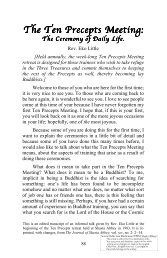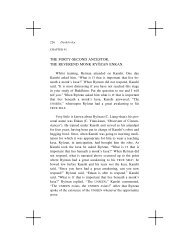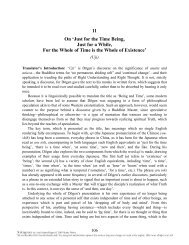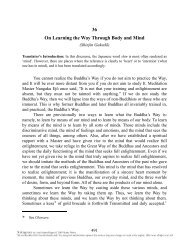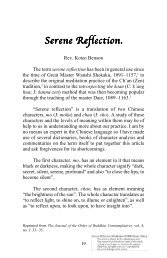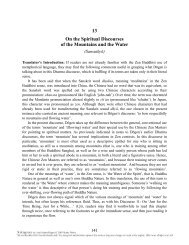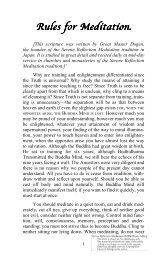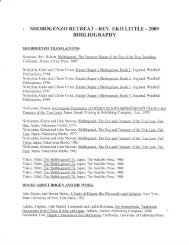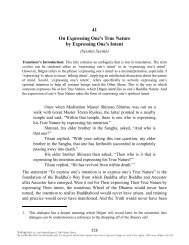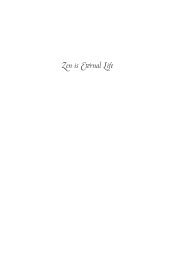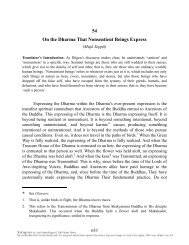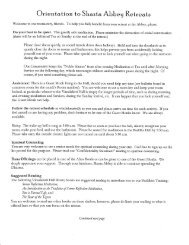32 On Kannon, the Bodhisattva of Compassion - Shasta Abbey
32 On Kannon, the Bodhisattva of Compassion - Shasta Abbey
32 On Kannon, the Bodhisattva of Compassion - Shasta Abbey
You also want an ePaper? Increase the reach of your titles
YUMPU automatically turns print PDFs into web optimized ePapers that Google loves.
<strong>32</strong><strong>On</strong> <strong>Kannon</strong>, <strong>the</strong> <strong>Bodhisattva</strong> <strong>of</strong> <strong>Compassion</strong>(<strong>Kannon</strong>)Translator’s Introduction: The name <strong>Kannon</strong> is a shortened version <strong>of</strong> Kanzeon (Skt.Avalokiteshvara), ‘The <strong>On</strong>e Who Heeds <strong>the</strong> Cries <strong>of</strong> <strong>the</strong> World’. This <strong>Bodhisattva</strong> goes undermany names and has taken many forms in India, as well as in o<strong>the</strong>r East Asian Buddhist cultures.Originally, Avalokiteshvara was iconographically represented as being male, but after <strong>the</strong> figurecame into China, it was <strong>of</strong>ten pictured as being female, although not exclusively so. From <strong>the</strong>standpoint <strong>of</strong> Buddhist iconography, <strong>the</strong> male aspect represents <strong>the</strong> personification <strong>of</strong>compassion, whereas <strong>the</strong> female aspect represents compassion in action. However, Buddhas and<strong>Bodhisattva</strong>s are said to have <strong>the</strong> ability to shift between <strong>the</strong>se two functions, depending onwhich seems to be <strong>the</strong> more spiritually helpful in a given situation. For a translator writing inEnglish, this presents a problem <strong>of</strong> how to refer to <strong>Kannon</strong>: as He or as She. Since a choice hasto be made, I have chosen to use masculine grammatical forms simply because, historically, this<strong>Bodhisattva</strong> is Indian in origin, where <strong>the</strong> figure is traditionally considered to be male and <strong>the</strong>name is grammatically masculine in gender.The compassion that is represented by <strong>Kannon</strong> has no limitations in its functioning, as <strong>the</strong>dialogue between <strong>the</strong> two bro<strong>the</strong>r-monks, Ungan and Dōgo, expresses. It is like eyes that seeeverything and hands that <strong>of</strong>fer help everywhere, even in <strong>the</strong> darkest <strong>of</strong> times. Some readers mayfind it difficult, on occasion, to follow what Dōgen is driving at in this discourse. To put itsimply, when it comes to conveying what <strong>the</strong> innate compassion <strong>of</strong> one’s Buddha Nature is, it isdifficult to express what is essentially beyond words to convey, and conventional ways <strong>of</strong> talkingabout <strong>the</strong> innate compassion <strong>of</strong> one’s Buddha Nature do not meet <strong>the</strong> mark. Therefore, eventhough Ungan and Dōgo successfully found a way <strong>of</strong> expressing what <strong>the</strong> compassion <strong>of</strong> BuddhaNature is like, <strong>the</strong> way that <strong>the</strong>y put <strong>the</strong> matter goes beyond conventional ways <strong>of</strong> understandingwhat is said. At times Dōgen explains what <strong>the</strong>y mean by using <strong>the</strong> via positiva (saying whatsomething is like) and at o<strong>the</strong>r times he does this by using <strong>the</strong> via negativa (saying whatsomething is not like).Ungan Donjō once asked Dōgo Enchi, 1 “What use does <strong>the</strong><strong>Bodhisattva</strong>* <strong>of</strong> Great <strong>Compassion</strong> make <strong>of</strong> His ever so many handsand eyes?”1. Ungan and Dōgo were both Dharma heirs <strong>of</strong> Yakusan Igen.* See Glossary.458
Shōbōgenzō: <strong>On</strong> <strong>Kannon</strong>, <strong>the</strong> <strong>Bodhisattva</strong> <strong>of</strong> <strong>Compassion</strong> 459Dōgo replied, “He is like someone in <strong>the</strong> night who reachesbehind himself, his hand groping for his pillow.”Ungan remarked, “I get it, I get it!”Dōgo asked, “What did you get?”Ungan said, “That His whole body is hands and eyes.”Dōgo replied, “What you have said is very well put. Still, itonly expresses eighty or ninety percent <strong>of</strong> <strong>the</strong> Matter.”*Ungan responded, “Well, so much for <strong>the</strong> likes <strong>of</strong> me. Howabout you, my elder bro<strong>the</strong>r in <strong>the</strong> Dharma, what do you make <strong>of</strong> it?”Dōgo replied, “That His whole being, through and through, ishands and eyes.”In expressing what <strong>Kannon</strong> is, many voices have been heard before and afterthis incident, but none <strong>of</strong> <strong>the</strong>m equal <strong>the</strong> words <strong>of</strong> Ungan and Dōgo. If you wish toexplore through your training what <strong>Kannon</strong> is, you should thoroughly investigatewhat Ungan and Dōgo are saying here. The <strong>Bodhisattva</strong> <strong>of</strong> Great <strong>Compassion</strong>spoken <strong>of</strong> here is Kanzeon Bosatsu, ‘The <strong>Bodhisattva</strong> Who Heeds <strong>the</strong> Cries <strong>of</strong> <strong>the</strong>World’, who is also known as Kanjizai Bosatsu, ‘The <strong>Bodhisattva</strong> Who ObservesAll Things Free <strong>of</strong> Attachments’. Through our training, we study Him, or Her, as<strong>the</strong> fa<strong>the</strong>r and mo<strong>the</strong>r <strong>of</strong> all Buddhas. So do not consider Him to be inferior to <strong>the</strong>Buddhas, thinking that He has not yet realized <strong>the</strong> Truth, for in <strong>the</strong> past He was <strong>the</strong>Tathagata known as ‘The Clarifier <strong>of</strong> <strong>the</strong> True Dharma’.So, let us now take up, and thoroughly explore, <strong>the</strong> words spoken by Ungan,namely, “What use does <strong>the</strong> <strong>Bodhisattva</strong> <strong>of</strong> Great <strong>Compassion</strong> make <strong>of</strong> His ever somany hands and eyes?” There are Buddhist traditions that make a point <strong>of</strong>honoring <strong>Kannon</strong>, and <strong>the</strong>re are Buddhist traditions that have not yet seen <strong>Kannon</strong>even in <strong>the</strong>ir dreams. The <strong>Kannon</strong> that existed for Ungan was in complete harmonywith Dōgo’s <strong>Kannon</strong>. And this was not so just for one or two <strong>Kannon</strong>s, but Unganwas likewise in harmony with hundreds <strong>of</strong> thousands <strong>of</strong> myriad <strong>Kannon</strong>s. <strong>On</strong>lyUngan’s assembly allowed <strong>Kannon</strong> to truly be <strong>Kannon</strong>. And why is that? Thedifference between <strong>the</strong> <strong>Kannon</strong> <strong>of</strong> which Ungan spoke and <strong>the</strong> <strong>Kannon</strong> <strong>of</strong> whicho<strong>the</strong>r Buddhas spoke is like <strong>the</strong> difference between being able to put It in wordsand not being able to put It in words. The <strong>Kannon</strong> <strong>of</strong> some Buddhas merely hadtwelve faces; this was not so for Ungan. The <strong>Kannon</strong> <strong>of</strong> some o<strong>the</strong>r Buddhasmerely had a thousand hands and eyes; this was not so for Ungan. The <strong>Kannon</strong> <strong>of</strong>still o<strong>the</strong>r Buddhas had eighty-four thousand hands and eyes; this was not so forUngan. How do I know this to be true? Because when Ungan speaks <strong>of</strong> <strong>the</strong><strong>Bodhisattva</strong> <strong>of</strong> Great <strong>Compassion</strong> using His ever so many hands and eyes, hisphrase ‘ever so many’ does not mean merely eighty-four thousand hands and eyes.
Shōbōgenzō: <strong>On</strong> <strong>Kannon</strong>, <strong>the</strong> <strong>Bodhisattva</strong> <strong>of</strong> <strong>Compassion</strong> 460How much less did he limit it to some particular number, like twelve or thirty-twoor thirty-three! ‘Ever so many’ is synonymous with ‘beyond count’. The phrase‘ever so many’ is not limited as to what sort or how many. Since it is not limited toany sort or amount, you should not limit it, not even by calculating it to be anunbounded, limitless amount. You need to explore through your training that <strong>the</strong>underlying meaning <strong>of</strong> <strong>the</strong> phrase ‘ever so many’ is just like this, for it has alreadygone beyond <strong>the</strong> bounds <strong>of</strong> <strong>the</strong> immeasurable and <strong>the</strong> unbounded.Now, in taking up Ungan’s phrase ‘His ever so many hands and eyes’, Dōgodid not say that it did not reveal <strong>the</strong> Matter, so it must have contained <strong>the</strong>underlying principle. Ungan and Dōgo were in complete harmony with each o<strong>the</strong>rand stood shoulder-to-shoulder, having already trained toge<strong>the</strong>r under Yakusan forforty years. During that time, <strong>the</strong>y had discussed accounts from both <strong>the</strong> past and<strong>the</strong> present, rooting out what was not correct and verifying what was correct.Because <strong>the</strong>y had trained toge<strong>the</strong>r in this manner, when on this day <strong>the</strong>y stated ‘Hisever so many hands and eyes’, Ungan was making a statement and Dōgo wasverifying it. Keep in mind that ‘His ever so many hands and eyes’ was beingdiscussed by both <strong>of</strong> <strong>the</strong>se Old Buddhas alike. Both Ungan and Dōgo are clearly inaccord concerning ‘His ever so many hands and eyes’, so Ungan now asks Dōgowhat use <strong>Kannon</strong> makes <strong>of</strong> <strong>the</strong>m. Do not consider his question to be <strong>the</strong> same as<strong>the</strong> types <strong>of</strong> questions raised by academic teachers <strong>of</strong> Scriptures and scholarlywriters <strong>of</strong> commentaries, or by <strong>the</strong> ‘thrice wise and ten times saintly’.* Thisquestion has elicited a spiritual affirmation: it has elicited ‘hands and eyes’. Now,<strong>the</strong>re may well be Old Buddhas, as well as more recent Buddhas, who haverealized Buddhahood through <strong>the</strong> force <strong>of</strong> Ungan’s having said, “What use does Hemake <strong>of</strong> His ever so many hands and eyes?” Ungan could also have said, “Whatdoes He accomplish by making use <strong>of</strong> His ever so many hands and eyes?” And hecould also have expressed <strong>the</strong> Matter as “What is it that He does?” or “What doesHe put into motion?” or “What is He expressing?”Dōgo replied, “He is like someone in <strong>the</strong> night who reachesbehind himself, his hand groping for his pillow.”To express <strong>the</strong> underlying principle, Dōgo gives as an example someone who isgroping behind himself for a pillow in <strong>the</strong> middle <strong>of</strong> <strong>the</strong> night. ‘Groping for’ means‘searching for’. ‘In <strong>the</strong> night’ is a way <strong>of</strong> saying ‘being in <strong>the</strong> dark’, just as wemight speak <strong>of</strong> ‘seeing a mountain in <strong>the</strong> light <strong>of</strong> day’. That is, ‘using one’s handsand eyes’ is like someone in <strong>the</strong> night reaching behind himself, his hand gropingfor a pillow. We need to investigate ‘using one’s hands and eyes’ on this basis. Andwe need to examine ‘in <strong>the</strong> night’ from <strong>the</strong> perspective <strong>of</strong> ‘in <strong>the</strong> light <strong>of</strong> day’, as
Shōbōgenzō: <strong>On</strong> <strong>Kannon</strong>, <strong>the</strong> <strong>Bodhisattva</strong> <strong>of</strong> <strong>Compassion</strong> 462Ungan’s words, “I get it, I get it!” are not saying, “I understand Dōgo’swords.” It is an “I get It, I get It!” in relation to his having made a statement about<strong>the</strong> hands and eyes that That Which Is makes use <strong>of</strong>, which will be Its making freeuse <strong>of</strong> <strong>the</strong> here and now, and Its having free entry into this present day.Although Dōgo’s expression, “What did you get?” is ano<strong>the</strong>r way <strong>of</strong> hissaying, “I’ve gotten It,” it is one which does not stand against Ungan’s “I get It.”Even so, Dōgo had his own way <strong>of</strong> putting “What did you get,” a way that means“I’ve got It and you’ve got It.” Would this not be equivalent to “Our eyes get It andour hands get It?” Is it referring to an understanding that has emerged or to anunderstanding that has not yet emerged? While <strong>the</strong> understanding implied by “I getit” is synonymous with <strong>the</strong> ‘I’, you need to consider that <strong>the</strong>re is a ‘you’ in “Whatdid you get?”What has come forth as a result <strong>of</strong> Ungan’s statement, “His whole body ishands and eyes,” is a plethora <strong>of</strong> <strong>Kannon</strong>s who, in speaking <strong>of</strong> ‘someone in <strong>the</strong>night reaching behind himself, his hand groping for his pillow’, are exploring it bystating that one’s whole body is nothing but hands and eyes. These <strong>Kannon</strong>s indeedare <strong>Kannon</strong>s, even though They have not yet been able to put it into Their ownwords. When Ungan said, “His whole body is hands and eyes,” he was not sayingthat hands and eyes are <strong>the</strong> Dharma Body which exists everywhere. Even thougheverywhere is <strong>the</strong> whole universe, <strong>the</strong> hands and eyes <strong>of</strong> our body at this instantwill not be <strong>the</strong> Everywhere that is everywhere. Even though <strong>the</strong> hands and eyes <strong>of</strong>our body can perform <strong>the</strong> meritorious actions <strong>of</strong> <strong>the</strong> Everywhere, <strong>the</strong>y cannot be<strong>the</strong> hands and eyes that leave <strong>the</strong> marketplace with stolen goods. The meritoriousactivities <strong>of</strong> hands and eyes will be beyond <strong>the</strong> sort <strong>of</strong> seeing, behaving, andexpressing that judges rightness. These hands and eyes are already described asbeing ‘ever so many’, so <strong>the</strong>y are beyond a thousand, beyond ten thousand, beyondeighty-four thousand, and beyond <strong>the</strong> immeasurable and <strong>the</strong> unbounded. Not onlyis it like <strong>the</strong> whole body being hands and eyes, it is also like giving voice to <strong>the</strong>Dharma in order to rescue sentient beings, and like letting loose <strong>the</strong> Lightthroughout <strong>the</strong> nations. Therefore, you should explore through your training that itmust be, as Ungan put it, that your whole body is hands and eyes. So, even thoughhe says to use your whole body as hands and eyes, and even though he says tochange your demeanor, now being active, now resting, do not let yourself bedisturbed by this.Dōgo replied, “What you have said is very well put. Still, itonly expresses eighty or ninety percent <strong>of</strong> <strong>the</strong> Matter.”
Shōbōgenzō: <strong>On</strong> <strong>Kannon</strong>, <strong>the</strong> <strong>Bodhisattva</strong> <strong>of</strong> <strong>Compassion</strong> 463The main point <strong>of</strong> what Dōgo said here is that Ungan’s expression is very well put.‘Putting it very well’ means that what one says hits <strong>the</strong> mark and that it clarifies <strong>the</strong>Matter, with nothing left unexpressed. When what has not been expressed before isnow finally expressed so that nothing remains that has not been expressed, it willstill only be expressing eighty or ninety percent <strong>of</strong> <strong>the</strong> Matter.Even if your exploration <strong>of</strong> <strong>the</strong> intent behind what Ungan said were onehundred percent, if you are still unable to put It in words, <strong>the</strong>n your have notthoroughly explored <strong>the</strong> Matter. And even if Ungan’s way <strong>of</strong> putting It was eightyor ninety percent <strong>of</strong> <strong>the</strong> Matter, it was still his expression <strong>of</strong> It, which might beeighty or ninety percent on <strong>the</strong> mark or one hundred percent on <strong>the</strong> mark. At thatvery moment in time, Ungan might have stated <strong>the</strong> Matter through hundreds <strong>of</strong>thousands <strong>of</strong> myriad expressions, but his abilities were so wondrous that he <strong>of</strong>feredonly a bit <strong>of</strong> his abilities and expressed a bare eighty or ninety percent <strong>of</strong> <strong>the</strong>Matter. For instance, even if he had had hundreds <strong>of</strong> thousands <strong>of</strong> myriad abilitiesto bring forth <strong>the</strong> whole universe, what he actually said would surpass his leaving<strong>the</strong> Matter unsaid. At <strong>the</strong> same time, were he to take up just one <strong>of</strong> his abilities, itwould not be an ordinary, worldly-wise ability. The meaning <strong>of</strong> this eighty orninety percent is like this. Even so, when people hear <strong>the</strong> statement by an Ancestor<strong>of</strong> <strong>the</strong> Buddha that someone has expressed eighty or ninety percent <strong>of</strong> <strong>the</strong> Matter,<strong>the</strong>y understand it to mean that it is only eighty or ninety percent because it doesnot come up to an expression that would be a hundred percent <strong>of</strong> <strong>the</strong> Matter. If <strong>the</strong>Buddha Dharma were like this, It would not have reached us today. You need toexplore through your training that <strong>the</strong> so-called ‘eighty or ninety percent’ is aneighty or ninety percent <strong>of</strong> ‘hundreds <strong>of</strong> thousands’, as if we were speaking <strong>of</strong>‘ever so many’. Dōgo had already stated ‘eighty or ninety percent <strong>of</strong> It’ and hecertainly knew that It must not be confined to a literal eighty or ninety percent. Weneed to explore through our training that this is <strong>the</strong> way that <strong>the</strong> Ancestors <strong>of</strong> <strong>the</strong>Buddha speak.When Ungan said, “So much for <strong>the</strong> likes <strong>of</strong> me. How about you, my elderbro<strong>the</strong>r in <strong>the</strong> Dharma, what do you make <strong>of</strong> it?” he said “so much for <strong>the</strong> likes <strong>of</strong>me” because he wanted Dōgo to put into words what he called ‘only expressingeighty or ninety percent <strong>of</strong> <strong>the</strong> Matter.’ Although this is his ‘not leaving any tracesbehind’, it is also ‘his arms being long and his sleeves being short’. 3 “While I have3. Ano<strong>the</strong>r way <strong>of</strong> expressing this is that, although his words leave no karmic wake (notleaving any traces behind), his intention in asking <strong>the</strong> question is obvious (his arms stickingout from his sleeves).
Shōbōgenzō: <strong>On</strong> <strong>Kannon</strong>, <strong>the</strong> <strong>Bodhisattva</strong> <strong>of</strong> <strong>Compassion</strong> 464not yet exhausted <strong>the</strong> ways <strong>of</strong> saying what I have just said, I leave <strong>the</strong> matter as itis” is not what his expression “So much for <strong>the</strong> likes <strong>of</strong> me” means.Dōgo said, “His whole being, through and through, is hands andeyes.”These words <strong>of</strong> his are not saying that hands and eyes, as independent entities, arewhat one’s whole being is through and through. What he is saying is that one’swhole being, through and through, is hands and eyes. As a consequence, he is notsaying that one’s body is what hands and eyes are. Since ‘with His ever so manyhands and eyes’ means ‘using His hands and using His eyes’, 4 His hands and eyesare, <strong>of</strong> necessity, <strong>the</strong> whole <strong>of</strong> Him being hands and eyes, through and through. Inasking, “What does He do with His ever so many bodies and minds?” <strong>the</strong>re will be<strong>the</strong> response, “His whole being, through and through, is whatever He is doing.”What is more, it is not <strong>the</strong> case that Ungan’s expression, ‘whole body,’ is not quitecomplete whereas Dōgo’s expression, ‘whole being, through and through,’ isthoroughly complete. Ungan’s ‘whole body’ and Dōgo’s ‘whole being, through andthrough’ are not open to any discussion <strong>of</strong> <strong>the</strong>ir comparative value, and <strong>the</strong> ‘ever somany hands and eyes’ that was stated by each <strong>of</strong> <strong>the</strong>m is an expression <strong>of</strong> ThatWhich Is.Thus, <strong>the</strong> <strong>Kannon</strong> <strong>of</strong> whom our old Master Shakyamuni spoke only had athousand hands and eyes, or twelve faces, or thirty-three bodies or eighty-fourthousand bodies. The <strong>Kannon</strong> <strong>of</strong> Ungan and Dōgo had ever so many hands andeyes and is beyond any talk about quantities. When you explore through yourtraining <strong>the</strong> <strong>Kannon</strong> <strong>of</strong> Ungan and Dōgo, which has ever so many hands and eyes,<strong>the</strong>n you, toge<strong>the</strong>r with all Buddhas, will realize eighty or ninety percent <strong>of</strong><strong>Kannon</strong>’s meditative state.Given on <strong>the</strong> twenty-sixth day <strong>of</strong> <strong>the</strong> fourth lunar month in <strong>the</strong> third year <strong>of</strong> <strong>the</strong> Ninji era (May27, 1242).4. The Chinese character, read as yō in Japanese, when functioning as a preposition means‘with’, and when functioning as a verb, means ‘to use’.
Shōbōgenzō: <strong>On</strong> <strong>Kannon</strong>, <strong>the</strong> <strong>Bodhisattva</strong> <strong>of</strong> <strong>Compassion</strong> 465❀ ❀ ❀Now, since <strong>the</strong> Buddha Dharma has come from <strong>the</strong> West, many Ancestors <strong>of</strong><strong>the</strong> Buddha have spoken about <strong>Kannon</strong>, but <strong>the</strong>y have not equaled Ungan andDōgo, and for that reason, I spoke only about this <strong>Kannon</strong> <strong>of</strong> <strong>the</strong>irs. As YōkaGenkaku said in his poem, “The Song That Attests to <strong>the</strong> Way”:Not stuck on seeing just one single thing: this we callbeing a Tathagata;Such a one can be called a Kanjizai, one who regards allthings just as <strong>the</strong>y are.This is evidence that even though <strong>the</strong> Tathagata and <strong>Kannon</strong> manifest in Theirparticular bodily forms, They are not separate beings.And <strong>the</strong>re was also an exchange between Mayoku and Rinzai concerning <strong>the</strong>true Hands and Eyes. 5 These are just a couple <strong>of</strong> cases among ever so many. Thereis Ummon’s statement, “There are <strong>the</strong> <strong>Kannon</strong>s who, upon seeing <strong>the</strong> forms <strong>of</strong>things, clarify Their minds, or who, upon hearing <strong>the</strong> sounds <strong>of</strong> things, awaken to<strong>the</strong> Way.” What sights and sounds are not encompassed within Kanzeon<strong>Bodhisattva</strong>’s seeing and hearing? And in Hyakujō’s words, “There is His gatewayfor entering into <strong>the</strong> Truth.” Among <strong>the</strong> assembly in <strong>the</strong> Shurangama Scripture,<strong>the</strong>re are <strong>the</strong> <strong>Kannon</strong>s who have fully realized <strong>the</strong> Way. And among <strong>the</strong> assemblyin <strong>the</strong> Lotus Scripture, <strong>the</strong>re is <strong>the</strong> <strong>Kannon</strong> who manifests everywhere. All <strong>the</strong>se<strong>Kannon</strong>s are identical with <strong>the</strong> Buddhas and They are identical with <strong>the</strong> great earthwith its mountains and rivers. Yet, at <strong>the</strong> same time, They are but one or two <strong>of</strong> <strong>the</strong>ever so many hands and eyes.Copied by me on <strong>the</strong> tenth day <strong>of</strong> midsummer in <strong>the</strong> third year <strong>of</strong> <strong>the</strong> Ninji era (June 9, 1242).Ejō5. This exchange is recounted in <strong>the</strong> Translator’s Addendum immediately following thisdiscourse.
Shōbōgenzō: <strong>On</strong> <strong>Kannon</strong>, <strong>the</strong> <strong>Bodhisattva</strong> <strong>of</strong> <strong>Compassion</strong> 466❀ ❀ ❀Translator’s Addendum fromBook 3, Kōan 44 <strong>of</strong> Dōgen’s Chinese Shinji Shōbōgenzō<strong>On</strong>ce while Mayoku Hōtetsu was training in Rinzai’s community, he askedRinzai, “Which is <strong>the</strong> true Eye <strong>of</strong> <strong>the</strong> <strong>Compassion</strong>ate <strong>On</strong>e with a Thousand Handsand Eyes?”Rinzai replied, “Which is <strong>the</strong> true Eye <strong>of</strong> <strong>the</strong> <strong>Compassion</strong>ate <strong>On</strong>e with aThousand Hands and Eyes? Well, quick, you tell me! Speak right up!”Thereupon, Mayoku pulled Rinzai down <strong>of</strong>f his chief monk’s seat in <strong>the</strong>Meditation Hall and sat himself down in Rinzai’s place.Rinzai got up <strong>of</strong>f <strong>the</strong> floor and said, “Well, how do you do!” Mayoku wasabout to respond, when Rinzai suddenly gave out a Zen shout, pulled Mayoku <strong>of</strong>f<strong>the</strong> chief monk’s seat, and sat back down on it.Mayoku got up <strong>of</strong>f <strong>the</strong> floor and [since he had been bested] left <strong>the</strong> hall.




